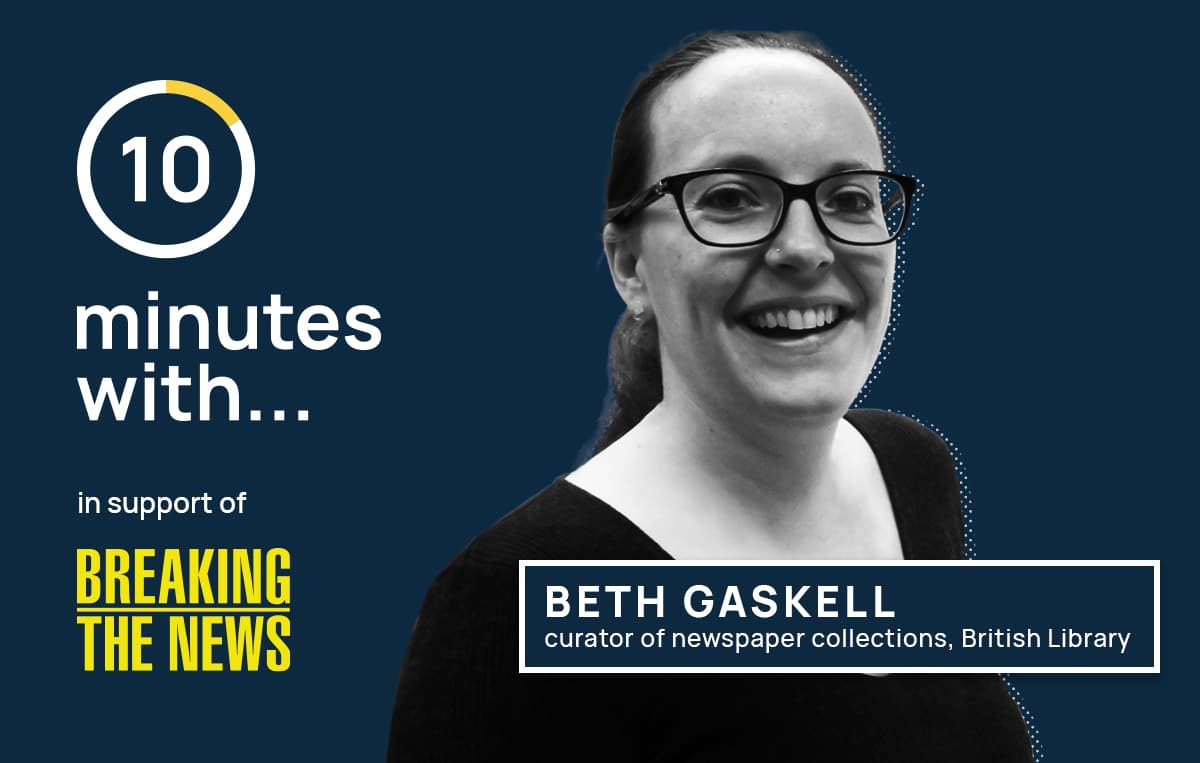In this special edition of ’10 minutes with’ celebrating the British Library’s ‘Breaking the News’ exhibition, Beth Gaskell talks about how she became a curator, which revolutionary item is her favourite artefact from the archive and why it’s so important to collect the nation’s news…
How did you become a news curator?
I’ve always had an interest in news and in the reporting of events. My first independent research project was as part of my A Levels, investigating the reporting of the Vietnam War.
I studied for a BA in English and History and an MA in Library and Information Studies, and then worked in a wide range of libraries, including at museums, think tanks, and research organisations.
After that, I studied for a PhD specialising in nineteenth-century newspapers and periodicals and it was while I was working on that that I spotted a job at the British Library.
What does the role entail?
I have responsibility for the library’s newspaper collection covering the period from 1800 to the present.
My role involves looking after the newspapers, working on projects to digitise, research, and promote our collections and liaising with a wide range of users to help them access and utilise the newspaper collection.
How has your role changed as news sources have become more digital?
There has been a shift in how we think about collecting and using material, in particular, thinking about how we can use the data that is created when news items are digitised.
What is your favourite news item in the archive?
My favourite item in the news collection is ‘The Lady’s Newspaper’ (1847-63), which was one of the earliest newspapers produced for an exclusively female audience.
It included all the items you would expect in a 19th century women’s magazine, such as fashion, book reviews, and serialised fiction. However, these appeared alongside in-depth political analysis and articles on current events.
This was a revolutionary step forward in women’s publishing.
Why is it important to archive the nation’s news?
I think the oft-repeated quote ‘those that fail to learn from history are doomed to repeat it’ sums it up well. A news archive contains so much of the history of the last 500 years, as our ‘Breaking the News’ exhibition aims to showcase.
What’s more, looking beyond history’s big events, a news archive is a vital resource for those looking at local or family history and for those researching more marginalised voices.
Why does journalism matter?
Knowledge is power and journalism is so often our source of knowledge. Journalism is how we find out about and make sense of our world.
Why should people come to the ‘Breaking the News’ exhibition?
Because not only does the exhibition span five centuries of news production and cover a wide range of interesting and challenging stories, but it also asks questions about what news actually is, how it shapes our world and how we as consumers play a role in shaping the news agenda.
You’re a journalist for a day – what would you cover?
I’d love to be able to cover some kind of historic discovery or recovery, like the raising of the Mary Rose warship or the discovery of the Staffordshire Hoard of gold and silver metalwork.
Fantasy dinner party guests?
All of the ‘News Breakers’ featured in the exhibition and in the accompanying book.
We wanted to celebrate people who have pushed boundaries to get a story told, from the first female editor Rachel Beer and photojournalist Mohamed Amin to campaigners Greta Thunberg and Malala Yousafzai.
It would be a strange mix of people, but we’d have some interesting conversations about news, education and free speech.
If you weren’t a curator, what would you be?
Growing up I always wanted to be a war correspondent, although I doubt I’m brave enough.
Gym or gin (or other guilty pleasure)?
Definitely gin, although I’m not at all guilty about it.

